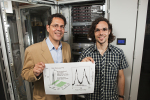Einstein@Home 'citizen scientists' discover a new pulsar in Arecibo telescope data
Idle computers are the astronomers' playground: Three citizen scientists - a German and an American couple -
have discovered a new radio pulsar hidden in data gathered by the Arecibo Observatory. This is the first deep-space
discovery by Einstein@Home, which uses donated time from the home and office computers of 250,000 volunteers from 192
different countries. (Science Express, Aug. 12, 2010.)
The citizens credited with the discovery are Chris and Helen Colvin, of Ames, Iowa and Daniel Gebhardt, of
Universität Mainz, Musikinformatik, Germany. Their computers, along with 500,000 others from around the world,
analyze data for Einstein@Home (on average, donors contribute about two computers each).
Learn more in the press releases and additional information provided below.
Documents
Click on the links to open documents in new window and for download.
Video and Audio
Click on the links to open media elements in new window and for download.

| Low resolution | Low quality | MPEG4 | 2 MB | Download |
| Low resolution | High quality | MOV/H264 | 14 MB | Download |
| High resolution | Low quality | MPEG4 | 10 MB | Download |
| High resolution | High quality | MOV/H264 | 58 MB | Download |
|

| Low resolution | Low quality | MPEG4 | 2.5 MB | Download |
| Low resolution | High quality | MOV/H264 | 13 MB | Download |
| High resolution | Low quality | MPEG4 | 14 MB | Download |
| High resolution | High quality | MOV/H264 | 69 MB | Download |
|

|
Artist's impression of PSR J2007+2722: view from Earth. In the second half of the animation, the rotation (white) and magnetic (yellow) axes and the line of sight (blue dot) are visible. The observed pulse profile is shown below the animation. The radio emission cone shows the beam intensity (yellow ring) explaining the pulse profile.
Copyright: AEI Hannover |
Artist's impression of PSR J2007+2722, view from the side. In the second half of the animation, the rotation (white) and magnetic (yellow) axes and the line of sight (blue arrow) are visible. The observed pulse profile is shown below the animation. The radio emission cone shows the beam intensity (yellow ring) explaining the pulse profile.
Copyright: AEI Hannover |
The pulsar's radio signal waveform when interpreted as an audio signal.
Copyright: AEI Hannover |
Pictures and Figures
Click on the images for a larger view and for download.
 |
 |
 |
 |
Aerial View of Arecibo Observatory, Arecibo, P.R. The facility is owned by the National Science Foundation and managed by Cornell University.
Copyright: Cornell University |
Einstein@Home discovery plot. (Left) significance as a function of DM and spin frequency (all E@H results for the discovery beam). (Right) the pulse profile at 1.5 GHz (GBT). The bar illustrates the extent of the pulse.
Copyright: AEI Hannover |
Position of PSR J2007+2722 (red circle) in the constellation of Vulpecula in the evening sky in August; simulated view of the sky with the naked eye.
Copyright: AEI Hannover, created with Celestia |
Position of PSR J2007+2722 (red circle) in the constellation of Vulpecula in the evening sky in August; constellations art overlaid for illustrative purposes.
Copyright: AEI Hannover, created with Celestia |
 |
 |
 |
all pictures... |
Close-up of the constellation Vulpecula with the position of PSR J2007+2722 (red circle); simulated view with binoculars.
Copyright: AEI Hannover, created with Celestia |
The Einstein@Home radio pulsar search screensaver.
Copyright: AEI Hannover |
Prof. Bruce Allen and graduate student Benjamin Knispel with discovery plot.
Copyright: Thomas Damm / AEI Hannover |
|
Other useful links
Science Contacts
Prof. Dr. Bruce Allen, Director
Max Planck Institute for Gravitational Physics (Albert Einstein Institute) and
Institute for Gravitational Physics at Leibniz Universität Hannover
Callinstraße 38,
30167 Hannover Germany
or
Prof. Bruce Allen
Physics Department
University of Wisconsin - Milwaukee
1900 East Kenwood Blvd.
Milwaukee WI 53211 USA
Prof. Jim Cordes
Department of Astronomy
Cornell University
Ithaca, NY 14853 USA
Dr. David Anderson
U.C. Berkeley Space Sciences Laboratory
7 Gauss Way
Berkeley, CA 94720
Press Contacts
Max Planck Institute for Gravitational Physics
(Albert Einstein Institute)
Felicitas Mokler
mokler@aei.mpg.de
+49.511.762.17098
Milde Marketing Science Communication
Susanne Milde
milde@mildemarketing.de
+49.331.583.9355
Arecibo Observatory and
Cornell University
Blaine Friedlander
bpf2@cornell.edu
+1.607.254.8093
University of Wisconsin-Milwaukee
Laura Hunt
llhunt@uwm.edu
+1.414.229.6447
University of California, Berkeley
Robert Sanders
+1.510.643.6998
rlsanders@berkeley.edu
American Physical Society
James Riordon
+1.301.209.3238
riordon@aps.org
National Science Foundation
Lisa-Joy Zgorski
+1.703.292.8311
lisajoy@nsf.gov









